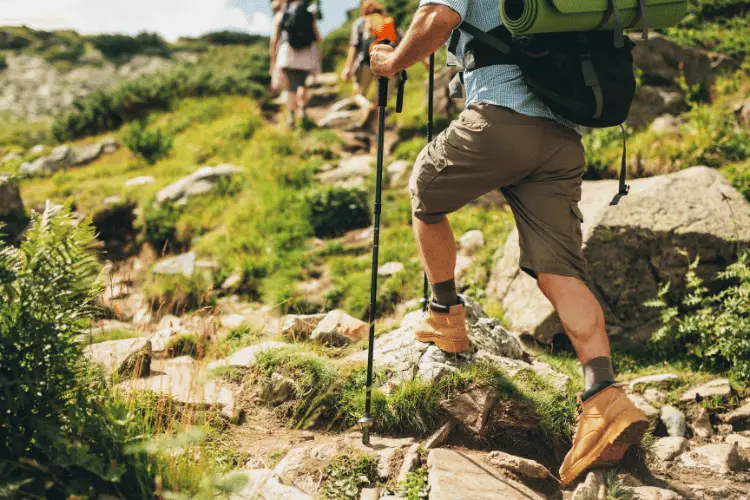Have you ever looked at the total mileage of a hike and wondered how much of it you can cover in a day?
The unpredictable and technical nature of a trail makes it difficult to determine the exact distance a person can cover in a day. There are so many factors to look into, such as your fitness level, your hiking experience, the altitude, the elevation—the list goes on.
Still, we can make educated guesses as to how much you can potentially cover over a given set of variables. So if you’ve ever asked yourself, “How many miles can I hike in a day?” stick around. This article discusses the factors that determine your hiking distance per day, as well as the average hiking pace, the Naismith Rule, and tips to help increase your hiking pace.
Let’s dive right in!
Factors That Determine Your Hiking Distance Per Day
Several factors affect your average hiking distance per day, such as:
1. Fitness Level
Naturally, those who are physically fit cover greater mileage than those who live a sedentary lifestyle or are just getting active.
If you’re a novice hiker who isn’t in the best shape, you may cover no more than three to five miles a day, depending on the terrain and environment.
But if you’re an experienced hiker who eats five miles for breakfast, you can cover 10, 15, or even 20 miles without breaking too much sweat.
A fit hiker can cover four miles in under an hour, while a beginner can take up to two and sometimes two and a half hours to cover the same. A person’s physical and cardiovascular health can ultimately influence the hiking distance.
2. Hiking Experience
Hiking doesn’t require any great skill, but it does have specific strategies to take on effectively—especially with longer and harder hikes.
Experienced hikers can navigate difficult terrain more efficiently than beginners, thus affecting the distance and duration of the hike.

3. Conditions of the Trail
The conditions of the trail can significantly affect how many miles you can hike in a day.
You’ll cover greater distances hiking on a well-maintained trail with little to no obstacles as opposed to a rocky or muddy trail with inclines and steep hills.
Diverse, multi-use trails can add an hour or two to your hiking time.
4. Altitude and Elevation
The steeper the elevation, the longer the hiking time. You’ll cover greater mileage hiking on a flat road at sea level than hiking up a hill at 10,000 feet above sea level.
When you reach altitudes of over 4,900 feet, you’ll start to notice a drop in oxygen. The lack of oxygen forces your heart to pump harder and faster to compensate, causing you to tire much quicker and therefore rest much longer, affecting your overall mileage per day.
For every 1,000 feet of elevation gain, an additional hour is added to your hiking time.
5. Weight of Your Gear
How heavy is the equipment you’re carrying? The heavier the gear, the slower you’ll hike and the longer it’ll take for you to reach your destination.
A loaded day hiking pack shouldn’t weigh more than 10% of your body weight, whereas a loaded backpacking pack shouldn’t weigh more than 20% of your body weight.
So, if you’re, say, 150 pounds, you should carry 15 pounds or less while day hiking and 30 pounds or less while backpacking.
Carrying less weight can help you travel farther, faster, and more comfortably. As such, you shouldn’t carry more than what’s necessary when out hiking.
Keep the essentials—first aid kit, water, energy bars, etc.—and leave out anything you’d carry along for “just in case” purposes. Do you really need that extra pair of underwear when hiking? The flashlight can stay, but what about those extra boots? And hey—is that a cooking pot?
Carrying a heavy backpack not only decreases your hiking mileage but also increases your risk of developing shoulder, neck, and back pains, as well as ankle sprains. The backpack will feel like a hindrance to your hike, so the lighter, the better.
6. Personal Factors
Personal factors like age, sex, average pace, and health also play major roles in determining how many miles you can hike in a day.
Walking speed decreases as your age increases, according to a study led by Dr. Michaela Schimpl. You walk about 1.2 minutes slower for every half-mile at age 60 than at age 20.
Older adults are less likely to get the recommended amount of weekly exercise, which is why they walk slower than their younger counterparts. The difference in speed is even more prominent when hiking, where terrain can greatly impact the walking speed.
Women tend to walk slower than men because men are often taller and have longer limbs, but the difference isn’t so significant.
It mostly comes down to your average pace per hike, which can be determined with a stopwatch on a 1-mile stretch. Note down how long it takes you to complete one mile at an average pace, a comfortable pace, and a tired pace, and then round up the figures to get an estimate.
7. Motivation and Interest Level
How long do you want to spend hiking in a day? Do you want to hike a full eight hours or a casual 30 minutes? Do you want to spend the majority of the time covering as much terrain as you can, or enjoy a comfortable walk admiring the scenery? The answers to these questions can determine how much distance you’ll cover on a hike.
It’s entirely possible to travel miles upon miles of terrain in a single day. As an example, American hiker Jesse Castenda covered an impressive 142 miles in 1976, earning the world record for the greatest distance walked in 24 hours. The question here isn’t if you can, but rather what you’re willing to sacrifice to push yourself to your limit.
If you’re planning to hike at a reasonable pace and enjoy the scenery along the way, you’ll be able to hike anywhere between five to 15 miles a day. If you’re aiming for a personal record, you can easily break the 15 miles with a bit of determination.
8. Weather Conditions
Hiking in pouring rain, high humidity, strong winds, or heavy snow will not only make the hike longer but also make it significantly more difficult. Therefore, you should always check the day’s weather forecast before you go out on a hiking trip lest you’re greeted with undesirable weather.

If you’re not one to let the weather stop you, prepare yourself for what’s to come. Wear a waterproof jacket, equip yourself with a pair of heavy-duty waterproof hiking boots, and wrap your hiking bag with a rain cover.
How Many Miles Can I Hike in a Day?
From fitness level and hiking experience to trail conditions and elevation, there are multiple factors in how far you can hike in a day. However, most studies conclude that a decently fit person can hike about eight to 15 miles a day.
Adults have an average hiking speed of around 2 to 2.5 miles per hour, meaning that it takes approximately 25 to 30 minutes to cover a mile. Therefore, it’ll take roughly five hours to hike 10 miles, six hours to hike 12 miles, seven hours to hike 14 miles, and so on.
Beginner hikers can cover anywhere between five to seven miles a day, whereas experienced hikers can reach distances of upwards of 30 miles a day. Nonetheless, most avid hikers cover no more than 12 miles a day as pushing further decreases the hike’s enjoyment.
What is the Naismith’s Rule?
Devised by Scottish mountaineer William W. Naismith, Naismith’s Rule is a formula that determines how long it’ll take a reasonably fit individual to complete a hike on typical terrain, under normal conditions.
The rule states that an hour is to be added for every three miles walked, plus an extra hour for every 2,000 feet of elevation gain.
Therefore, hiking a mile on flat terrain at a brisk pace will, on average, take 20 minutes. This isn’t accounting for backpack weight, weather, breaks, and terrain among others, so you’ll need to modify the formula according to these variables to determine your average hiking distance.
For example, the distance from Mount Everest’s Base Camp to the summit is around 12.75 miles. If we take Naismith’s Rule at face value, we can estimate that it’ll take around six to seven hours to complete the given distance.
But the reality is far more complicated. Mount Everest is one of, if not the toughest and most dangerous mountains to climb. Though the distance is a mere 12.75 miles, it’ll take up to 12 to 14 days to complete the trek due to the elevation and harsh environmental conditions.
Naismith’s Rule is a good baseline for calculating average hiking distance and speed. But it’s important to note that the rule assumes you’re of average health hiking on moderate terrain during fair weather. It doesn’t account for navigational obstacles and other variables that can greatly affect your hiking time.
What is the Average Hiking Pace?
On flat terrain, the average hiking pace is around three miles per hour. On uneven terrain with 1,000 feet of elevation, the average pace is two miles per hour. This means that a 15-mile day hike might take you anywhere between eight to nine hours.
But again, just because you can doesn’t mean you should. While it’s tempting to cover as much as you can to set a personal record or prove a point, you should always prioritize your safety and enjoyment.
Hiking, while challenging, is meant to be fun and exciting. Going too fast or too hard increases your risk of injury, jeopardizing your entire trek. It can also make you feel so miserable that you lose heart in the adventure and never try it again.
How to Increase Your Hiking Speed
Here are some tips to follow to help you cover more mileage in less time:

Take Fewer Breaks
Breaks give you the opportunity to rest and recharge. The more difficult the trek, the more important they become.
That said, try not to be too generous with your breaks. Keep them close to 10 minutes and don’t go over 15 minutes, with the exception of one mandatory extended break.
Moreover, only take breaks when you’re tired. This could happen every 60 minutes or every 90 minutes. If you find yourself struggling to catch your breath, you’re overdue for a break.
Find a shaded area to sit on, remove your boots, stretch your toes, and have a snack. Enjoy the scenery for a few minutes before proceeding with your journey.
Do Thorough Research on Your Path
Before going on a hike, familiarize yourself with the route ahead. Map out obstacles, slopes, and natural monuments to figure out the best and most efficient trail.
You can look up the route through Google Maps, OpenStreetMap, or the National Trails System Webmap provided by the National Park Service.
Reduce Your Backpack Weight
A heavy backpack can increase your hiking time. Leave out unnecessary items at home and carry only the essentials to maintain a faster pace. Your backpack should weigh no more than 10% of your weight for a single-day hiking trip. Some essentials are as follows:
- First aid kit
- Navigation tools
- Water and easy-to-eat no cooking food, like hiking bars, trail mix, and sandwiches
- Flashlight
- Spare change of clothes
- Walking pole(s)
Improve Your Fitness Level
Hiking is a labor-intensive activity that calls for cardiovascular endurance and muscular strength. Without a proper fitness level, you’ll be too busy catching your breath to actually advance through your hike.
Therefore, you should regularly incorporate hiking workouts into your fitness regime to increase your hiking distance and speed. Here are the best exercises to improve your muscle strength and cardiovascular endurance for hiking:
- Squats
- Lunges
- Crunches
- Running and/or walking on sand
- Downhill lunges
- Step-ups
- Push-ups
- Deadlifts
- Stairmaster
- Stretching
Fuel Your Hike With Energy-Dense Snacks
Energy-dense snacks, like beef jerky, granola bars, peanut butter and banana sandwiches, and trail mix, keep you energized and moving, allowing you to trek longer and farther.
Hiking Poles Are Your Best Friends
Hiking poles, also known as trekking poles, give you that much-needed stability when passing through streams, river crossings, and rock formations.
They can also help you sustain good hiking for longer periods, as the repetitive motion of foot, pole, foot, pole, can somewhat be meditative during the hike.
And most importantly, hiking poles take some stress off your joints, especially on ascents and descents. This results in lesser breaks and therefore higher mileage.
Final Thoughts
The answer to the question “How many miles can I hike in a day?” depends on multiple variables, such as your fitness level, your hiking experience, trail conditions, altitude and elevation, and others. Personal factors like sex, age, average pace, and health can affect your overall mileage as well.
On average, a decently fit person can hike around eight to 15 miles a day. Beginner hikers can cover between five to seven miles, while experienced hikers can cover up to 30 miles.


